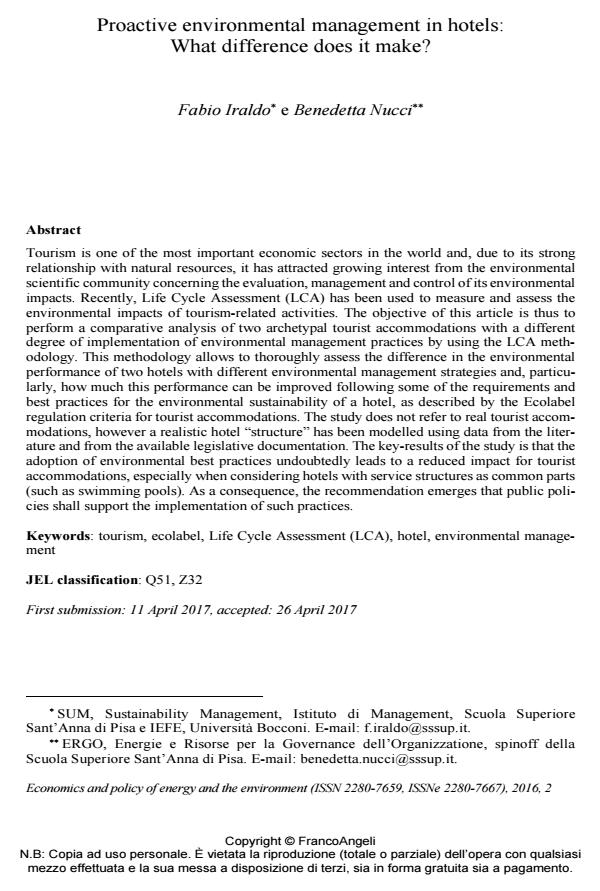Proactive environmental management in hotels: What difference does it make?
Journal title ECONOMICS AND POLICY OF ENERGY AND THE ENVIRONMENT
Author/s Fabio Iraldo, Benedetta Nucci
Publishing Year 2017 Issue 2016/2
Language English Pages 26 P. 81-106 File size 2802 KB
DOI 10.3280/EFE2016-002005
DOI is like a bar code for intellectual property: to have more infomation
click here
Below, you can see the article first page
If you want to buy this article in PDF format, you can do it, following the instructions to buy download credits

FrancoAngeli is member of Publishers International Linking Association, Inc (PILA), a not-for-profit association which run the CrossRef service enabling links to and from online scholarly content.
Tourism is one of the most important economic sectors in the world and, due to its strong relationship with natural resources, it has attracted growing interest from the environmental scientific community concerning the evaluation, management and control of its environmental impacts. Recently, Life Cycle Assessment (LCA) has been used to measure and assess the environmental impacts of tourism-related activities. The objective of this article is thus to perform a comparative analysis of two archetypal tourist accommodations with a different degree of implementation of environmental management practices by using the LCA meth-odology. This methodology allows to thoroughly assess the difference in the environmental performance of two hotels with different environmental management strategies and, particu-larly, how much this performance can be improved following some of the requirements and best practices for the environmental sustainability of a hotel, as described by the Ecolabel regulation criteria for tourist accommodations. The study does not refer to real tourist ac-commodations, however a realistic hotel "structure" has been modelled using data from the literature and from the available legislative documentation. The key-results of the study is that the adoption of environmental best practices undoubtedly leads to a reduced impact for tourist accommodations, especially when considering hotels with service structures as common parts (such as swimming pools). As a consequence, the recommendation emerges that public policies shall support the implementation of such practices.
Keywords: Tourism, ecolabel, Life Cycle Assessment (LCA), hotel, environmental man-agement
Jel codes: Q51, Z32
- Sustainability and Environmental Impact of the Tourism Sector: Analysis Applied to Swimming Pools in the Hotel Industry on the Costa Brava Núria Arimany-Serrat, Juan-Jose Gomez-Guillen, in Environmental Processes 55/2023
DOI: 10.1007/s40710-023-00665-4 - Economic-Environmental Law Guarantee of the Green and Sustainable Development: Role of Health Expenditure and Innovation Lin Yang, in Frontiers in Public Health 910643/2022
DOI: 10.3389/fpubh.2022.910643 - Greener Future Enakshi Dutta, Tajinder Jassal, Vishal Soodan, Nitin Gupta, pp.155 (ISBN:978-1-83608-989-6)
Fabio Iraldo, Benedetta Nucci, Proactive environmental management in hotels: What difference does it make? in "ECONOMICS AND POLICY OF ENERGY AND THE ENVIRONMENT" 2/2016, pp 81-106, DOI: 10.3280/EFE2016-002005